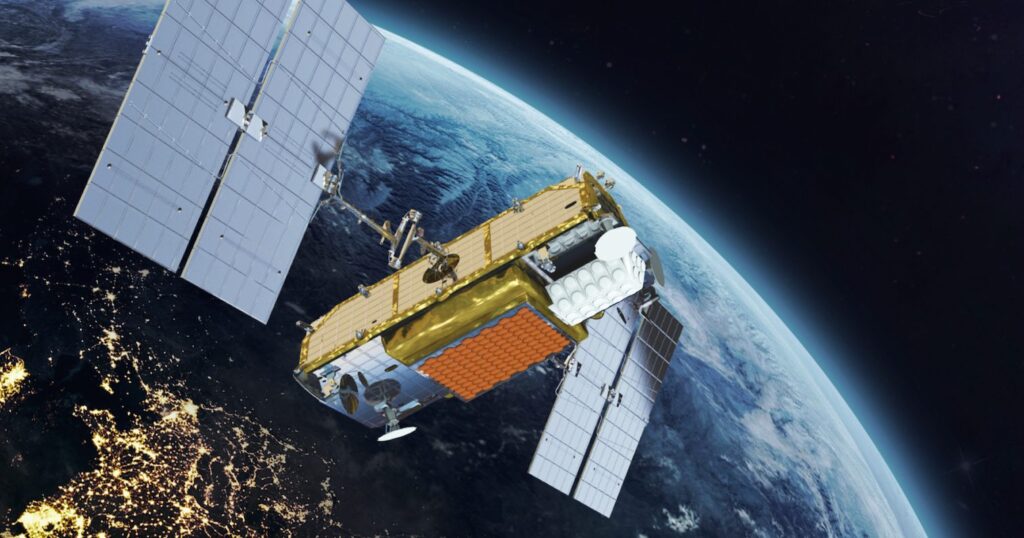
Iridium, which has 66 operational satellites in low Earth orbit, is teaming with Qualcomm to provide direct-to-cellular 5G communications. (Iridium)
WASHINGTON — The Space Force is planning later this year to request bids from providers of wireless phones enabled to connect with satellite networks, according to Clare Grason, director of the Commercial Space Communications Office (CSCO).
“The capability itself is very exciting to us,” she told a webinar Tuesday sponsored by Breaking Defense and Intelsat, explaining that it will enable the Defense Department “to equip warfighters with smaller and lighter, more capable, less expensive communication devices.”
Noting the increasing number of recent partnerships between satellite operators and wireless phone providers, such as that between T-Mobile and SpaceX and Qualcomm and Iridium, she explained that “some of these architectures will enable existing smartphones to seamlessly communicate with satellites using the cellular spectrum that’s been allocated to that to that [cell phone] provider.”
CSCO is currently working to develop a request for proposals (RFP), Grason said.
“I think we’re probably not looking at RFPs being released until later this year. But it is something for industry to keep their eyes open for and, and obviously, our customers. If you have any thoughts on that, we are in the market research phase, we’re open to feedback,” she said.
CSCO is the sole DoD authority for acquisition of commercial satellite communications services and capabilities. It serves as a middleman between commercial satellite operators and then matches them to the needs of various operational commands and other DoD customers — helping manage the contracting process. The office formerly was an arm of the Defense Information Systems Agency (DISA), but was transferred to Air Force Space Command in 2018 and now resides under Space Force’s acquisition unit, Space Systems Command, although DISA still handles contracting.
The plan is for CSCO to set up a contracting vehicle that allows military users to buy satellite-direct-to-cellular communications capability as a service, along the lines of CSCO’s ongoing initiative to provide DoD customers with satellite communications (SATCOM) and internet access via large constellations in low Earth orbit.
The office released an RFP last fall for use of what is colloquially known as “p-LEO” services, and via DISA expects to make its first contract awards “around the May timeframe,” she noted.
“Essentially what that contract will do is establish the p-LEO marketplace for the DoD. Instead of having been a requirements based acquisition — where by we traditionally ask offerers to bid to very specific coverage areas or technical requirements — we’ve asked offerers to provide essentially any available capability that they are willing to sell us or customized for us from this orbital regime,” Grason said.
“Additionally, we plan to have an ‘open season’ every year, so for companies that are being conceptualized, that once they reach a certain maturity level, they, too, will be able to onboard into this marketplace,” she added.
T-Mobile and SpaceX announced last August their plan to connect “vast majority of smartphones already on T‑Mobile’s network to Starlink satellites.” The two firms intend to create a new network, broadcast from Starlink’s satellites using T-Mobile’s mid-band spectrum nationwide, at first providing text services, adding voice and data coverage at a later stage.
Qualcomm and Iridium in January announced that they are collaborating to bring satellite connectivity for 5G communications to Android phones. Qualcomm’s new Snapdragon Satellite service — that the company claims is “the world’s first satellite-based two-way capable messaging solution for premium smartphones” — will be use Iridium’s L-band satellite spectrum for uplink and downlink.
Further, Hughes Network Systems, working with DISH Network, OneWeb and EchoStar satellite operators, last March scored an experimental contract to develop a military-only SATCOM empowered 5G network. That contract is part of the Defense Department’s multifaceted 5G experimentation initiative to wire a number of military bases, called the Next Generation Information Communications Technology program. In 2020, the Pentagon issued contracts to 15 vendors worth approximately $600 million for network building at five military bases, and in 2021 issued solicitations for another seven bases in 2021 to bring the total to 12.
Meanwhile, the Federal Communications Commission (FCC), which licenses US telecommunications firms to access radio frequency spectrum, is eyeing changes to processes that would ease such partnerships between satellite and terrestrial providers.
The FCC on Feb. 23 issued a Notice of Proposed Rulemaking [PDF] that “would facilitate the integration of satellite and terrestrial networks by proposing a new regulatory framework for Supplemental Coverage from Space (SCS).”
The proposed changes would allow satellite-to-cellular communications by letting sats use spectrum already licensed to wireless cell phone providers, the notices explains.
“Through this novel approach, satellite operators collaborating with terrestrial service providers would be able to obtain Commission authorization to operate space stations on currently licensed, flexible-use spectrum allocated to terrestrial services,” according to the notice. “This would enable expanded coverage to a terrestrial licensee’s subscribers, especially in remote, unserved, and underserved areas, and would increase the availability of emergency communications.”
The FCC will debate the NPRM at its next open meeting March 16.
‘The bad day’: DISA’s forthcoming strategy prepares for wartime coms
“It’s great to have internet day to day in peacetime,” said Lt. Gen. Robert Skinner, director of the Defense Information Systems Agency, “but it’s more imperative to have it when bullets are flying.”


























